When Do the Orioles Come Back to Wisconsin
Getting their name from the Latin aureolus, meaning golden, attracting these brightly colored birds, is all about timing. Your best chance of attracting them is when they first arrive in the early spring.
Cold, tired and hungry from migration, and faced with the arduous task of building their nest, orioles need all the help they can get when it comes to feeding sources. For the best chance to see these beautiful songbirds, start early and follow these tips to catch a glimpse of these sometimes elusive birds.
1. Use oriole specific feeders
Although it is not unusual for orioles to try and use hummingbird feeders, their tongues are too big, and they lack the ability to hover around them, often knocking them down (3). Use oriole-specific feeders and make sure your feeder has large enough perches and drinking ports.

Since they are greatly attracted to vibrant colors, especially orange, oriole feeders usually come in bright yellow and orange hues. Orioles need large perches and drinking ports for their large tongue and specific feeders will account for this. As a bonus, oriole-specific feeders often include additional features such as places to put ripe fruit or other treats for your birds.
2. Add a moving water source
All birds need water to avoid dehydration and maintain health and orioles are no different. They are especially attracted to shallow dishes and moving water (5). Strategically place bird baths near feeders to entice birds to use this convenient water source.

Orioles love the sight and sound of moving water, so if your bath has a bubbler, mister, or dripper, even better. Be careful to use basins no more than 2 to 3 inches deep to give them an optimal place to drink and bathe. Just like feeders, water sources should be kept clean and clear of debris for the health of your birds.
3. Switch to mealworms in summer
Jelly and fruit give orioles an energy boost needed for migration during the spring and fall months, but orioles often switch their diet to more protein-rich foods during summer months. During this time, their diet consists of mostly insects to give them the additional protein needed for breeding and raising their young.

Once nesting season begins, provide your birds more nutritional value by sprinkling mealworms on top of jelly cups. Once they stop coming for the jelly, keep your orioles coming all summer long by offering dried mealworm in a separate cup or tray.
Orioles may also visit suet feeders, especially if suet is offered in small chunks they can easily nibble, but keep in mind suet may not work in your climate during hotter temperatures.
4. Right feeder location is the key
Orioles are treetop birds, so keep this in mind when hanging feeders. Think like a bird and place feeders out in the open so they can be seen while birds fly overhead or sit high atop their perches.
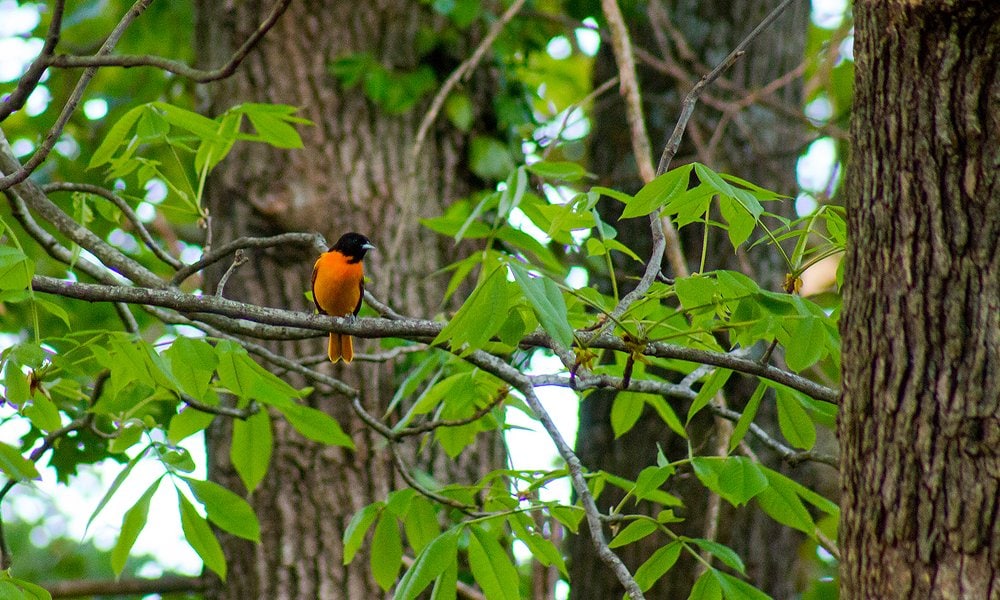
These shy birds may not venture that close to busy areas until they are used to the setting, so keeping feeders separated from human activity and other feeding areas will help the birds feel more secure and allow them to feed in peace. And lastly, be patient – it often takes several seasons to not only attract orioles but have them return year after year.
5. Add an orange ribbon to your backyard
Similar to hummingbirds, Orioles also have an attraction to bright and flashy colors. Feeders are often orange to make use of this fact. While hummingbirds prefer red, orioles are attracted most to vibrant orange (1).
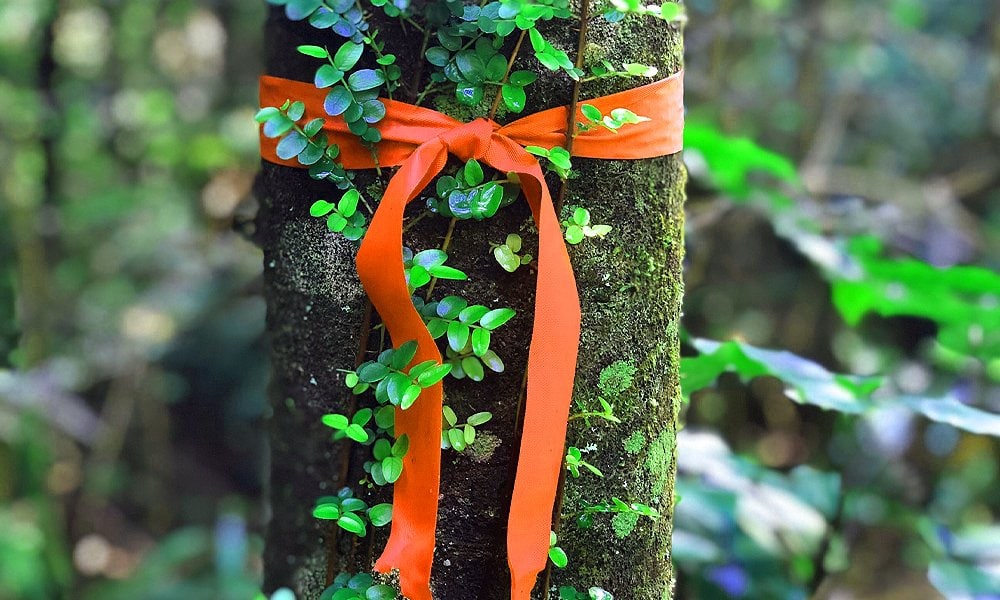
Brighten up your landscape to catch the eye of any orioles passing overhead. Tie orange ribbons, strips of cloth, or surveyors tape around trees, bushes, railings, or high in branches to attract their attention. These elusive birds prefer high canopies and these flashes of color may entice them to take a closer look at your yard and feeding stations.
6. Offer homemade nectar
While they may not have the metabolism of a hummingbird, orioles also enjoy drinking sugar water or nectar for an instant energy boost. Suitable nectars can be purchased, but making a nectar solution is simple, and you can use the same recipe for both hummingbirds and orioles. Keep your feather friends safe with this simple mixture of four parts hot water to one part sugar.
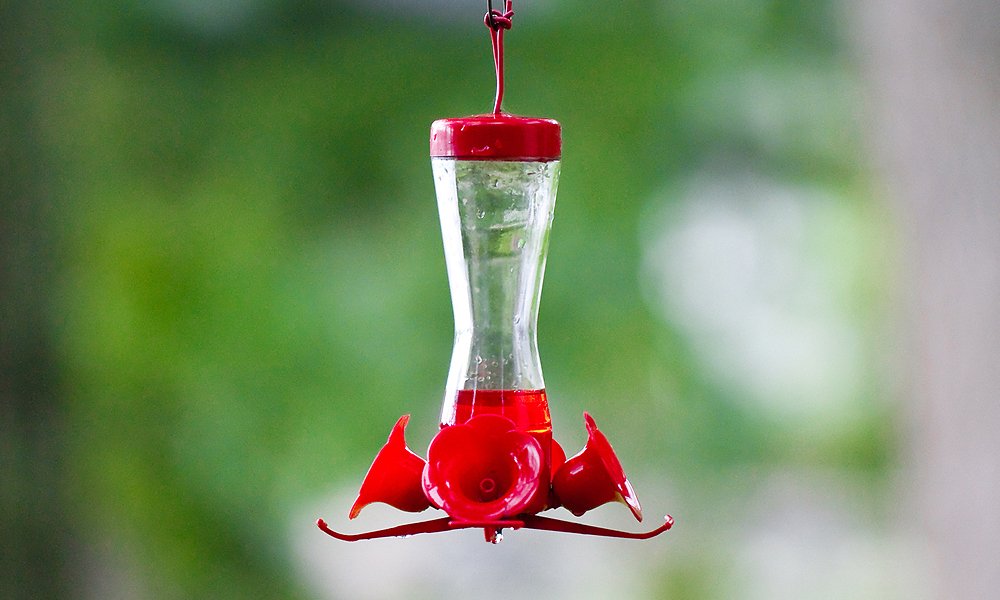
Stir the mixture until the sugar is completely dissolved and cool to room temperature. That's it. Nothing extra, like added sweeteners or honey, is needed.
Hot water is typically enough to dissolve the sugar, but boiled water is best and helps the mixture last longer (up to a week) when stored in your fridge. Remember to keep your nectar fresh and never use food coloring.
7. The secret is to start attracting orioles early
When it comes to attracting orioles to your yard, timing is everything. Cold, tired, and hungry from migrating at night, orioles will look for a reliable food source and stick to it.
The secret is to put feeders out at least a week or two ahead of their anticipated spring migration. If the birds don't spot the feeders as soon as they arrive, they're unlikely to start using them later.

Orioles being arriving as early as April in the southern states and continue until May further north. Start putting feeders out in late March or early April to attract the first arrivals, and keep them out late into the fall as birds migrate down south again. Maximize your opportunity to see these birds by making your yard a reliable source for them year after year.
8. Tempt with grape jelly
Migration takes a lot of energy, so tempt your birds with an energizing food source like grape jelly. Unlike many other fruit-eating birds, orioles seem to prefer only ripe, dark-colored fruit, and you can attract them by offering small amounts of this dark jelly at your feeding stations (4).

Jelly is best served in a cup or a shallow dish, but make sure to keep them clean. Like any sugary food, the jelly will be quick to mold or attract other unwanted visitors. You can use small tins or plastic lids, but be sure to fasten them to something, or the birds will knock it right to the ground. Make jelly last longer by combining one part jelly with one part water in a blender until it has the consistency of thick juice.
Also read: 5 Best Oriole Feeders [Nectar, Jelly & Fruit]
9. Encourage nesting in your yard
Orioles look for tall deciduous trees to build their unique and remarkable nests. While orioles do not nest in bird houses, you can encourage them to build their nests in your yard if you have willow, elm, oak, poplar, cottonwood, or similar trees. Orioles prefer to use materials such as plant fibers, strips of bark, grasses, vines, and strings for their tightly woven hanging nests.
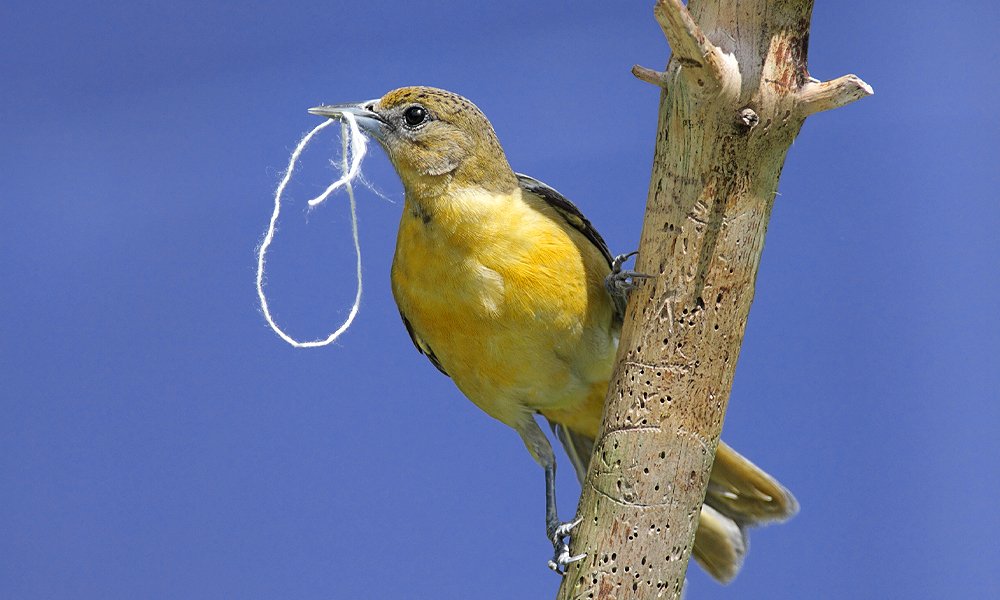
Offer slender fibers such as pet fur, hair, or 3-4 inch lengths of yarn for the birds to weave into their sock-like hanging nests. Although nests are usually anchored quite high, orioles will re-use nesting material each year, so it is beneficial to leave old nests up for birds to salvage from next spring.
10. Plant the right flowers
Native plants and flowers offer the best nutrition to attract feathered friends to your backyard. While nectar feeders are great supplements, birds can't resist the real deal. Fill your garden with nectar-producing flowers and vibrant orange hues for the best chance at bringing in orioles.
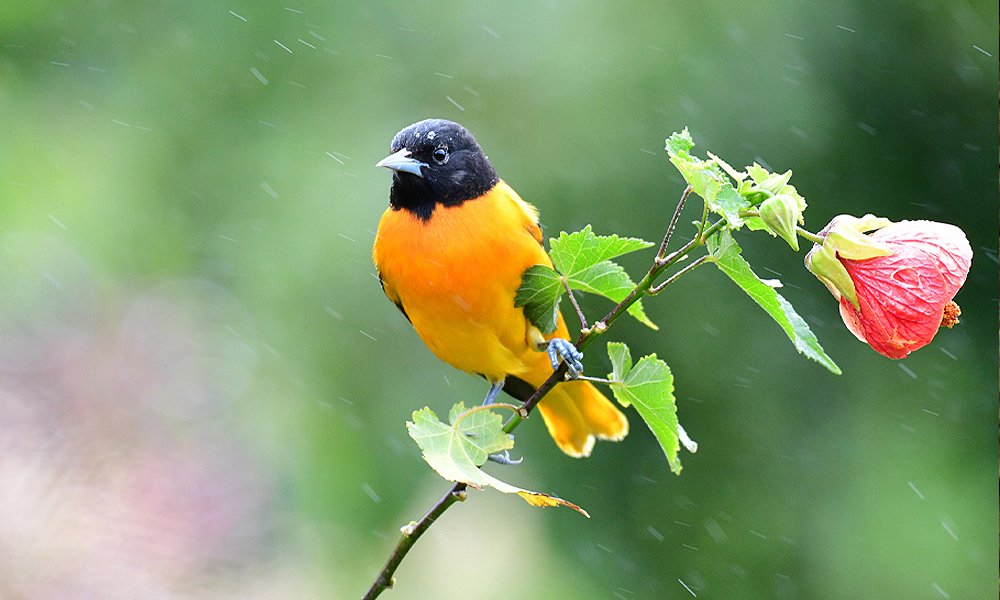
You can find lists online to find native plants that will grow in your area if you're just getting started, but daisies are always a safe start (6). In addition to the nectar, native plants also help offer a host of insects beneficial to the birds. Garden flags, gazing balls, a painted bench, or even a decorative trellis all offer additional options to add a boost of oriole-attracting color.
Also read: 12 Best Solar Bird Bath Fountains & Pumps
11. Keep ants out of the feeder
As you can imagine, sweet treats for orioles often means creepy-crawly pests at your feeders too. Ants, bees, and other insects are especially attracted to the sweet nectar and fruit halves you may be set out for your feather friends. Straight jelly and orange halves have the highest sugar ratio, so it will draw the most bugs and should be changed regularly to avoid contamination.
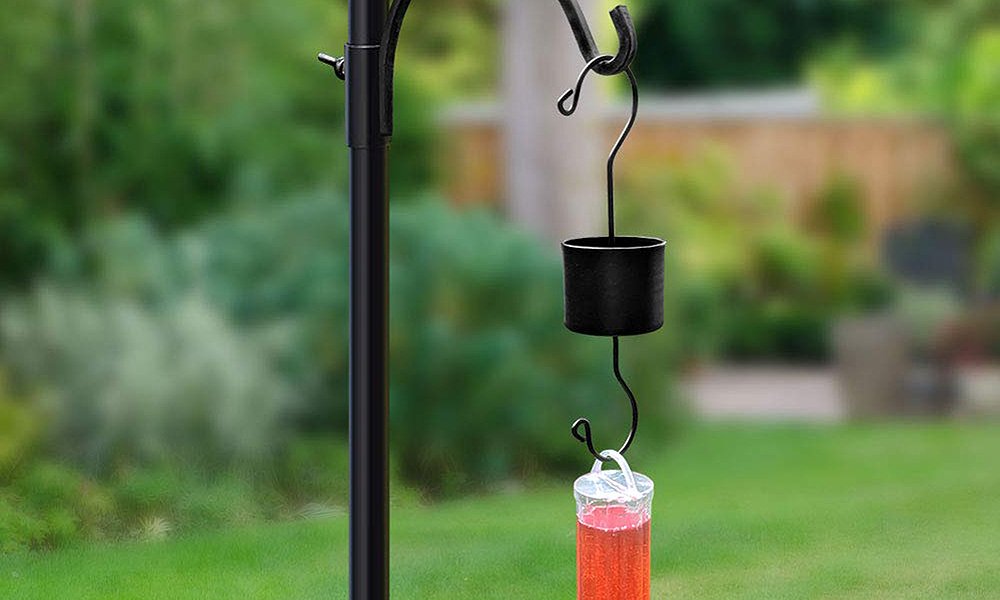
Add a simple ant moat to your feeder to keep them from clogging the holes. If your feeder doesn't come with ant or bee guards, try rubbing a small amount of vegetable oil near the feeder holes to discourage insects.
Related: 12 Tips on How to Keep Ants OUT of Hummingbird Feeder
12. Plant the right bushes
Of course, the best way to attract orioles to your yard is to make it as enticing to them as possible by providing landscaping that is both beautiful and beneficial. Plant fruit and berry-producing bushes such as mulberries, serviceberries, brambles, cherries, or figs. Orioles prefer dark-colored fruits, so bushes such as blueberries, blackberries, elderberries are also a plus.
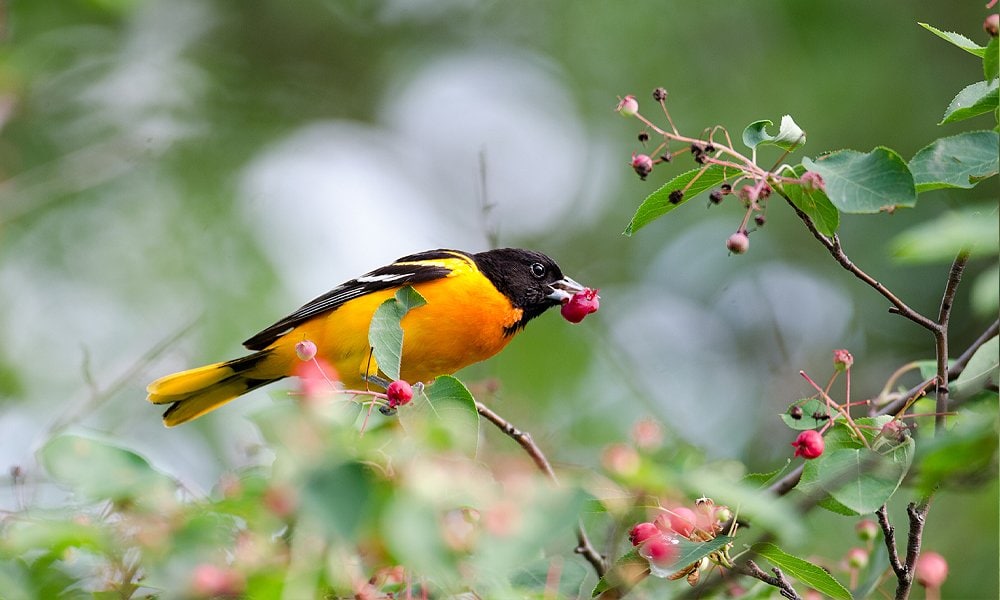
Orioles are also attracted to many of the same plants as hummingbirds. Bee balm, honeysuckle, cardinal flower, and Mandevilla are favorites and will attract many other bird species to your yard as well. Fill your yard with native flowering plants, vines, shrubs, and trees to keep the orioles coming back year after year.
When Do the Orioles Come Back to Wisconsin
Source: https://worldbirds.com/attracting-orioles/
0 Response to "When Do the Orioles Come Back to Wisconsin"
Post a Comment